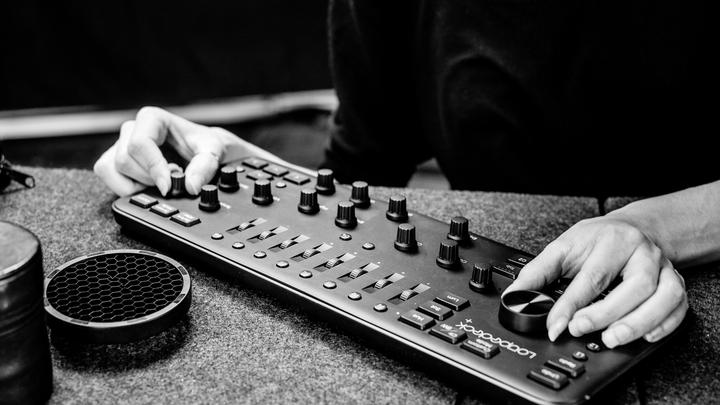
I’ve seen peripherals like the Loupedeck+ and its competitors around the market for a while now and I’ve been quite skeptical about the practicality of their use. Not that they are bad things, just that I’ve spent so many years with a keyboard & mouse combo that the thought of learning a new device to work on my images caused me a near panic attack. I will, however, admit that after getting hands on with the updated Loupedeck+ after WPPI 2019 that my opinion has changed greatly! While I’m still pretty clunky with it, the ease of use, accuracy, customization and versatility with the variety of supported apps make it more than worth the $249 price tag.
What Is It?
The Loupedeck+ is a photo & video editing console or keyboard that was created (initially by crowdfunding) to help you edit your photos & videos faster and easier than via the computer/mouse combination. It takes the software version of your sliders in Adobe Lightroom (among others) and gives you a physical button to use instead. I can also confirm that the knobs actually give you more control, or better accuracy than when using just the mouse in most of the applications as well.
[REWIND: Introducing Loupedeck+ | Loupedeck Gets An Upgrade & No Longer Just For Lightroom]
At Loupedeck, We’re Passionate about each and every step of the photo and video editing process. From first shoot to the final edit, we know it’s the small details that often make the biggest difference between a good image or video and a great one.
Quality
Having not been familiar with the first generation of Loupedeck, I did a fair bit of homework as well as picking the brains of the folks at SLR who did the initial review here. Among the biggest “cons” that I found from users with the original was the actual build quality. From what they’ve told me and what I’ve seen in my own use of the Loupedeck+, while the dimensions are the same, the quality of the product has improved significantly. The console is sturdier and the buttons/dials have a much more stable and satisfying feel when pressed and adjusted.
Another improvement is the addition of completely customizable functions, buttons, and a much improved software/plugin & interface.
Setup & Install
Here’s what I loved about this product. The first thing you have to do is download the updated software/drivers for your operating system from the Loupedeck Website and install them like any other application. Once you’ve done that, just plug in the console via the USB cable and that’s it. The system even recognizes when you’ve connected the device and lets you know that it’s running. That’s literally it. No confusion, no crazy setups; it’s just ready to go out of the box.

As you can see from my screencap above, if you open the application the system recognizes which application is “using” the devices and from here, if you choose to, you can go crazy and start customizing the buttons and layouts to suit your personal preference. Regardless of whether or not you do, as you turn the dials and buttons on the console, the relating sliders and settings in Lightroom (or the other supported applications) adjust accordingly.
Using It / The Process
So here was my personal bottleneck using the Loupedeck+. I’ve had such a muscle memory developed for Lightroom after using it in the same process every day for nearly a decade that moving to this hardware was a bit of a challenge. I was actually afraid that it would take me days, if not weeks, to actually get used to and comfortable with this peripheral. As mentioned above, it nearly gave me a panic attack when I was looking at the PILE of client work I needed to rush through.
Once I got over that initial anxiety and actually started to play with the device, I was kinda blown away with how easy it was to get used to. In fact, I even found myself using more of the available sliders/features in LR simply because they were laid out so clearly in front of me and not hidden in my often collapsed menus on screen. The part that got me was just how accurate adjusting the dials was compared to manually dragging the sliders in the OS. I found myself happier with my edits and have started to test out more features and creative tools that usually were glanced over in the past.

If you’re anything like me, you’ll find yourself looking at the screen, finding the slider, then looking back to the Loupedeck+ and finding the corresponding Dial/Button, making an adjustment, and then looking back at the screen & sliders and back again to make sure everything worked the way it should…and then you’ll realize you’re wasting a ton of time and you can just focus on the image while making fast and accurate adjustments with a newfound muscle memory for each of the preferred dials & buttons in your workflow.
Granted, I’m still not up to the speed I want to be with it, but it’s starting to feel natural and that’s making the difference every time I’ve sat down to edit. The learning curve is actually quite simple once you actually start to use it.
Price Point
The original Loupedeck launched with a price point of $300 US and now the updated Loupedeck+ is available for just $249. While that may seem steep, when you compare it to the other options on the market, it’s actually one of the best and most affordable ones out there. Especially when you look at the extreme high end console/decks for video production that start at price points of nearly $10,000. If you spend a lot of time working in any of the applications listed below (with more being added), $249 is a very small price to pay for the amount of time it can save you and the amount of creative control it will add for you!
Check out the pricing from our preferred retailers below;
Who Is It For?
Let’s get straight to it. If you’re in the business of dealing with a large number of files like a wedding or event photographer, than this is the device for you. It feels like that is the primary target market for the Loupedeck company and it definitely works there. As a wedding or event photographer, this would make editing a lot more fun, especially since I can sit back at my desk with the console on my lap and work away with ease on my images.

Even if you’re not a wedding or event photographer there is still a lot of value in this device for portrait and landscape shooters. Since speed isn’t really at the front of your requirements, this device will let you get more flexible and creative with your edits, finding and using more features within lightroom than you may have without, thus letting you explore many more possibilities with your final images.
The only market I didn’t see any real value beyond the “fun” portion was Commercial Photography. The reason here is typically in this world you’re shooting for a specific look, culling images quickly, and then editing small batches (if not just a single file) in Photoshop to meet a client deadline. Again, maybe as a commercial photographer you’d love it, but terms of a first impression and its broad usage, that’s really about the only field I felt wouldn’t get the most out of it.
So if you’re a high volume shooter, or you spend a lot of time in Adobe Lightroom already making every image absolutely perfect, it may be worth knocking on your friends door to borrow their loupedeck to see if the device is right for you.
Technical Details
Supported Software
- Adobe Lightroom Classic CC
- Adobe Premiere Pro CC
- Adobe Photoshop CC
- Adobe After Effects CC
- Adobe Audition
- Final Cut Pro X
- Skylum Aurora HDR
- Beta Support for Capture One Pro
System Requirements
- Adobe Lightroom® 7.4 or later
- Adobe Lightroom 6
- Adobe Photoshop CC
- Aurora HDR
- Beta integration with Capture One
- Adobe Premiere Pro CC 2019
- Apple Final Cut Pro X 10.4.5
- Adobe Audition CC 2019
- Windows® 10, Windows® 8.1
- Mac® OS 10.12 or later version
- Internet connection needed for Loupedeck ™ software download
- USB 2.0 A
Upgrades to the Loupedeck+ include:
- Mechanical keys with a more precise and sturdy feel
- Improved build quality
- Two dedicated customizable dials and seventeen buttons
- “Custom Mode” that allows full user control of all dials
- Configuration software built from scratch for an even better, faster and more stable photo editing experience
- Additional application support for Adobe Premiere Pro, Photoshop, After Effects, Audition, Final Cut Pro X, Skylum Aurora HDR, and beta support for Capture One Pro
Things to Improve Upon Still
- Wireless support like with wacom tablets would be a huge addition
- Addition of tilt functions like most keyboards have for additional ergonomic benefits
For More information on the Loupedeck+ be sure to check out the loupedeck blog here.
[REWIND: Loupedeck Review | A Thorough Review Of The Lightroom Controller Console]
If you’re reading this you’re likely into post processing, and if you really do and want to absorb lots of this kind of information, I highly suggest you take a look at our Lightroom Organization & Workflow workshops. Premium SLRL Members get access to it all. They’ll get you up to speed, and fast, allowing you to get the most out of this program we spend so much time with.
8.0 Score
Pros
- Cool Form Factor
- Supports a ton of applications
- Setup software is easy to use
- Build Quality is greatly improved form 1st generation
- Mechanical Keys & Sturdy buttons feel great to use
- Customization is a breeze
Cons
- No WIreless / bluetooth connectivity
- No Ability to tilt or adjust height like a normal keyboard for ergonomics
- No Ability to re-label / change pre-configured buttons and controls
Final Verdict
While the layout by default doesn't flow the way we're used too in lightroom, the fact that there's so much customization available definitely makes up for it. Once you get past the learning curve of using a console instead of your mouse to edit, the Loupedeck+ is a massive timesave and creative inspiration tool for your photography that we'd highly recommend.







Get Connected!